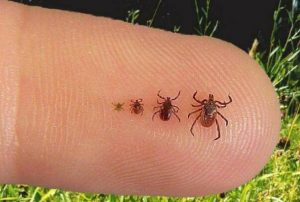By JENNFIER HELLER
Guest Opinion
The nymph ticks are coming out from hiding and they are hungry!
If you find tiny black specks on your legs, there’s a good possibility that these are a nymph form of ticks. They are less than one millimeter in size and only have six legs. The black-legged tick and the lone star nymphs are human biters.
The black legged tick is known to transmit Lyme disease bacteria, ehrlichia, anaplasmosis and Powassan virus. The Lone Star ticks are the carriers of ehrlichia, tularemia, Heartland virus, Bourbon virus and the alpha-gal sugar molecule which causes a reaction to red meat, dairy and foods with gelatin for up to five years.
 A single tick will progress through four stages of development in its lifetime: egg, larva, nymph, and adult. The nymph tick is most active in the spring through the summer months, and it’s about the size of a poppy seed. Submitted photo
A single tick will progress through four stages of development in its lifetime: egg, larva, nymph, and adult. The nymph tick is most active in the spring through the summer months, and it’s about the size of a poppy seed. Submitted photo
The other types of ticks we may find here are the American Dog Tick, which can transmit Rocky Mountain Spotted Fever, and tularemia. The Brown Dog tick usually only feasts on our canine pals but can bite people.
There are also some new invaders in our area, the Gulf Coast Tick, with a pretty white pattern on the back and the Asian Long-horned tick. As with the other ticks mentioned, they can also spread a form of spotted fever or other bacteria.
To help prevent these ticks in your yard, keep it well mowed, they usually don’t stay in sunlit areas if they can find shade.
Here’s tip from AARP: fill toilet paper cardboard tube with dryer lint that you spray with Permerthins. Mice will take the stuffing to make nests and ticks that bite the mice die.
Ticks are on the rise for many factors that are debated among scientists. Could be warmer, wetter, winters, or broken forested patches, or the growth of deer populations or mice populations, there’s no one definite reason agreed upon. You can be sure though that we are seeing more of these annoying creatures crawling around.
So — to help keep ticks off of you and yours, follow this advice:
Wear repellent.
Check for ticks daily (even if you haven’t gone outside, pet animals can bring them in).
Shower soon after being outside.
Call your doctor if you get a fever or rash after a tick bite.
If you find a tick attached on your body, use tweezers to grasp as close to the skin as possible and pull gently. If you squeeze their middle, they will release stomach contents into where they are biting.
Save the tick in a jar for two weeks to make sure you don’t get a rash or fever. If you do become ill, you can show the doctor the tick which will help identify your illness by the type of tick.
Here’s a website for more information: www.in.gov/isdh/27792.htm.
Jennifer Heller is the environmental health specialist for the Brown County Health Department. She is responsible for restaurant inspections, septic installation inspections, vector issues, farmer’s markets and home base vendor questions and complaints. She also chairs the Terrorism and All Hazards Preparedness Committee for the Indiana Environmental Health Association and will be the president-elect of that organization in 2022. She can be reached by at [email protected].





